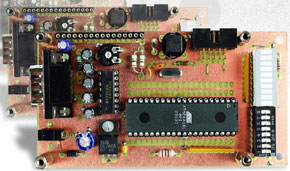Article
Mini ATmega Board
For ATmega16 and ATmega32

It’s about time, you might say! After all, even if the ATmega microcontroller isn’t necessarily mega, it’s still quite popular and we feel it hasn’t really received the attention it deserves in Elektor Electronics. The Mini ATmega Board described in this article puts a change to that, and a nice application for it — our Standalone OBD2 Analyser— is featured in an accompanying article.
Materials
Component list
Resistors
R1 = SIL array 8 x 1k
R2 = SIL array 8 x 10k
R3 = 10k
R4 = 10
R5, R5A = 39
R6 = 1k
P1 = 10k preset
Capacitors
C1, C2, C13, C14 = 100nF ceramic
C3, C4 = 22pF
C5-C9 = 1µF 16V radial
C10 = 47pF
C11 = 220µF 25V radial
C12 = 10µF 16V radial
Semiconductors
D1 = LED-Array with 10 LEDs
D2 = 1N4001
D3 = contained in D1
IC1 = ATmega 16-PC (DIP40 case)
IC2 = MAX232 (DIP16 case)
IC3 = 7805 (TO220 case)
Miscellaneous
JP1-JP4 = wire link, microswitch or 2-way pinheader with jumper)
K1 = 10-way boxheader
K2, K2A = 20-way SIL pinheader
K3, K3A = optionally fitted
K4 = 9-way sub-D plug (male), PCB mount
K5 = 16-way SIL socket, (e.g. cut off from a 40-way wirewrap socket) and mating SIL plug
K6 = mains adaptor DC socket, PCB mount
IC socket, 1 x 40 way, 1 x 20 way, 1 x 16 way
S1 = 8-way DIP switch
S2 = pushbutton, 1 make contact (e.g. Conrad Electronics # 700665)
L1 = 10 ?H (fixed inductor)
X1 = 8MHz quartz crystal
Enclosure, Hammond type 1591-D blue *
16-way flatcable (a few centimetres)
PCB, order code 050176-1, supplied including programming adapter board 050176-2.
* not required in combination with OBD2
** see SHOP pages
programming adaptor
Resistors (SMD 0805)
R1,R5 = 10k
R2,R3 = 4k7
R4 = 33k
Capacitors (SMD 0805)
C1 = 220pF
Semiconductors
D1,D2,D3 = zener diode 5V1, 250 mW, SOT23 case (e.g. BZX84 5V1 SOT23)
T1 = BC847 (SOT23)
Miscellaneous
K1 = 9-way sub-D socket (female) with case
K2 = 10-way pinheader
10-way flatcable (0.5 - 1 m)
10-way UIDC connector for flatcable
PCB, order code 050176-2 (see SHOP pages)
R1 = SIL array 8 x 1k
R2 = SIL array 8 x 10k
R3 = 10k
R4 = 10
R5, R5A = 39
R6 = 1k
P1 = 10k preset
Capacitors
C1, C2, C13, C14 = 100nF ceramic
C3, C4 = 22pF
C5-C9 = 1µF 16V radial
C10 = 47pF
C11 = 220µF 25V radial
C12 = 10µF 16V radial
Semiconductors
D1 = LED-Array with 10 LEDs
D2 = 1N4001
D3 = contained in D1
IC1 = ATmega 16-PC (DIP40 case)
IC2 = MAX232 (DIP16 case)
IC3 = 7805 (TO220 case)
Miscellaneous
JP1-JP4 = wire link, microswitch or 2-way pinheader with jumper)
K1 = 10-way boxheader
K2, K2A = 20-way SIL pinheader
K3, K3A = optionally fitted
K4 = 9-way sub-D plug (male), PCB mount
K5 = 16-way SIL socket, (e.g. cut off from a 40-way wirewrap socket) and mating SIL plug
K6 = mains adaptor DC socket, PCB mount
IC socket, 1 x 40 way, 1 x 20 way, 1 x 16 way
S1 = 8-way DIP switch
S2 = pushbutton, 1 make contact (e.g. Conrad Electronics # 700665)
L1 = 10 ?H (fixed inductor)
X1 = 8MHz quartz crystal
Enclosure, Hammond type 1591-D blue *
16-way flatcable (a few centimetres)
PCB, order code 050176-1, supplied including programming adapter board 050176-2.
* not required in combination with OBD2
** see SHOP pages
programming adaptor
Resistors (SMD 0805)
R1,R5 = 10k
R2,R3 = 4k7
R4 = 33k
Capacitors (SMD 0805)
C1 = 220pF
Semiconductors
D1,D2,D3 = zener diode 5V1, 250 mW, SOT23 case (e.g. BZX84 5V1 SOT23)
T1 = BC847 (SOT23)
Miscellaneous
K1 = 9-way sub-D socket (female) with case
K2 = 10-way pinheader
10-way flatcable (0.5 - 1 m)
10-way UIDC connector for flatcable
PCB, order code 050176-2 (see SHOP pages)



Discussion (0 comments)